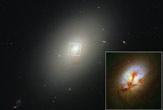Old Galaxy Still Giving Birth to Baby Stars

A galaxy thought to be over the hill is apparently still hard at work creating baby stars, a new study finds.
Photos taken by the Hubble Space Telescope show the core of an elliptical galaxy known as NGC 4150, which was thought to be beyond its fertile years for star formation, awash in streamers of dust, gas and clumps of young, blue stars that are significantly less than 1 billion years old. [Hubble photo of the galaxy NGC 4150]
The observations suggest that elliptical galaxies like this still have some youthful vigor left, thanks to encounters with smaller galaxies. The evidence also suggests that the star birth in NGC 4150 was sparked by a collision and merger with a dwarf galaxy.
"Elliptical galaxies were thought to have made all of their stars billions of years ago," said astronomer Mark Crockett of the University of Oxford, leader of the Hubble observations, in a release. "They had consumed all their gas to make new stars. Now we are finding evidence of star birth in many elliptical galaxies, fueled mostly by cannibalizing smaller galaxies."
The findings could change astronomers' views of how these galaxies form, he said.
"These observations support the theory that galaxies built themselves up over billions of years by collisions with dwarf galaxies," Crockett said. "NGC 4150 is a dramatic example in our galactic backyard of a common occurrence in the early universe."
Astronomers used Hubble telescope's powerful Wide Field Camera 3 to observe NGC 4150The Hubble images reveal turbulent activity deep inside the elliptical galaxy's core. Clusters of young, blue stars trace a ring around a center that is rotating with the galaxy. The stellar breeding ground is about 1,300 light-years across. Long strands of dust are silhouetted against the yellowish core, which is composed of populations of older stars.
Get the world’s most fascinating discoveries delivered straight to your inbox.
From a Hubble analysis of the stars' colors, Crockett and his team calculated that the star-formation boom started about a billion years ago, a comparatively recent event in cosmological history. The galaxy's star-making factory has slowed since then.
"We are seeing this galaxy after the major starburst has occurred," explained team member Joseph Silk of the University of Oxford. "The most massive stars are already gone. The youngest stars are between 50 million and 300 to 400 million years old. By comparison, most of the stars in the galaxy are around 10 billion years old."
The team's results will be published in an upcoming issue of the Astrophysical Journal.
- Photos: 20 Years of the Hubble Space Telescope
- Video: Spiral Galaxy Evolution
- Top 10 Most Amazing Hubble Discoveries
This article was provided by SPACE.com, a sister site of LiveScience.com.

